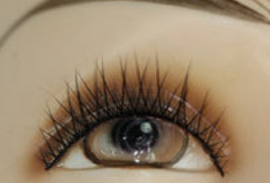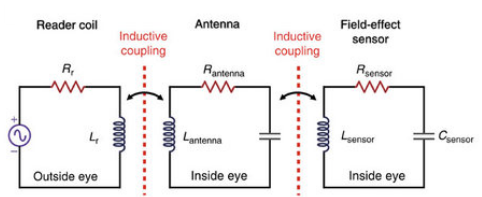A ‘smart contact lens’ for diabetes and glaucoma diagnosis
May 10, 2017

Smart contact lens on mannequin eye (credit: UNIST)
Korean researchers have designed a “smart contact lens” that may one day allow patients with diabetes and glaucoma to self-monitor blood glucose levels and internal eye pressure.*
The study was conducted by researchers at Ulsan National Institute of Science and Technology (UNIST) and Kyungpook National University School of Medicine, both of South Korea.
Most previously reported contact lens sensors can only monitor a single analyte (such as glucose) at a time, and generally obstruct the field of vision of the subject.
The design is based on transparent, stretchable sensors that are deposited on commercially available soft-contact lenses.
Electrodes based on a hybrid graphene-silver nanowire material can measure glucose in tears. Internal eye pressure changes are measured by a sandwich structure whose electronic characteristics are modified by pressure.
Inductive coupling — batteries not required
Both of these readings are transmitted wirelessly using “inductive coupling” (similar to remote charging of batteries), so no connected power source, such as a battery, is required. This design also allows for 24-hour real-time monitoring by patients.
The researchers conducted in-vivo and in-vitro performance tests using a live rabbit and bovine eyeball.
The team expects that the research could also lead to developing biosensors capable of detecting and treating various other human diseases, or used as a component in other biomedical devices.
The study results were published in the March issue of the journal Nature Communications. The study was supported by the 2017 CooperVision Science and Technology (S&T) Awards Program.
* Diabetes is the most common cause of high blood sugar levels. Intraocular pressure is the largest risk factor for glaucoma, a leading cause of human blindness.
How the smart contact lens works

Schematic of the top portion of the wearable contact-lens sensor. Left: antenna. Insert: Glucose sensor, based on a field-effect transistor (FET), which consists of a graphene channel and graphene/silver nanowire for source/drain. Not shown: chromium/gold interconnect, epoxy layer, and lens (below). (credit: UNIST)

Real-time glucose sensing with graphene/silver hybrid nanostructures. For selective and sensitive detection of glucose, glucose oxidase (GOD) catalyzes oxidation of glucose to gluconic acid and reduction of water to hydrogen peroxide, which produces oxygen, protons and electrons. The concentration of charge carriers in the FET channel, and thus the drain current, increases at higher concentration of glucose. (credit: UNIST)

The FET sensor (right) is modeled as an electrical RLC resonant circuit, comprised of the resistance (R) of the graphene channel, the inductance (L) of the antenna coil made of the graphene-AgNW hybrid, and the capacitance (C) of graphene-AgNW hybrid S/D electrodes. Wireless operation is achieved by mutually coupling the sensor antenna (center) with an external reader antenna (left) at a resonant frequency of 4.1 GHz. (credit: UNIST)

Schematic of intraocular pressure monitoring. A layer of silicone elastomer was placed between the two inductive spirals made of graphene-AgNW hybrid electrodes in a sandwich structure. The contact lens sensor responds to raised intraocular pressure (ocular hypertension), which increases the corneal radius of curvature, which in turn increases both the capacitance by thinning the dielectric and the inductance by bi-axial lateral expansion of the spiral coils. As a result, ocular hypertension shifts the reflection spectra of the spiral antenna to a lower frequency. (credit: UNIST)
Abstract of Wearable smart sensor systems integrated on soft contact lenses for wireless ocular diagnostics
Wearable contact lenses which can monitor physiological parameters have attracted substantial interests due to the capability of direct detection of biomarkers contained in body fluids. However, previously reported contact lens sensors can only monitor a single analyte at a time. Furthermore, such ocular contact lenses generally obstruct the field of vision of the subject. Here, we developed a multifunctional contact lens sensor that alleviates some of these limitations since it was developed on an actual ocular contact lens. It was also designed to monitor glucose within tears, as well as intraocular pressure using the resistance and capacitance of the electronic device. Furthermore, in-vivo and in-vitro tests using a live rabbit and bovine eyeball demonstrated its reliable operation. Our developed contact lens sensor can measure the glucose level in tear fluid and intraocular pressure simultaneously but yet independently based on different electrical responses.